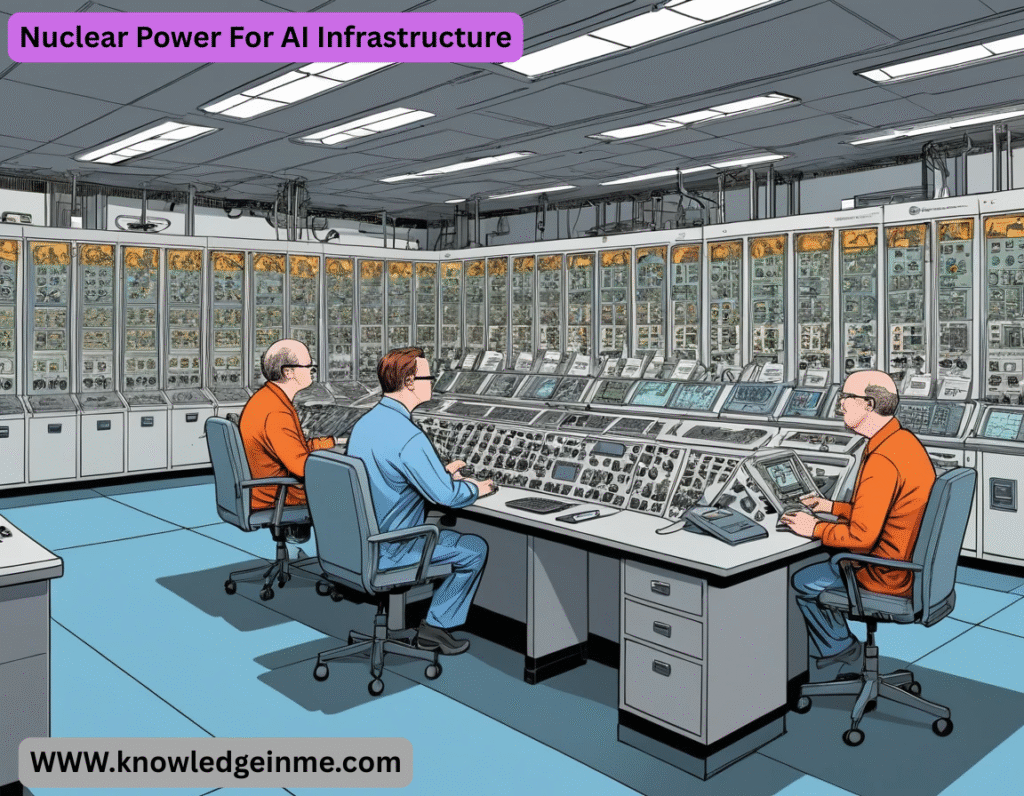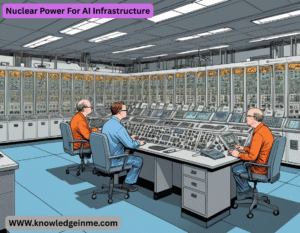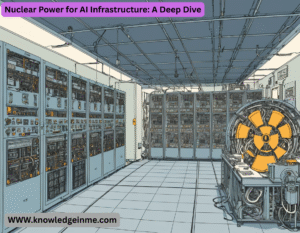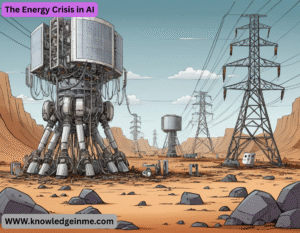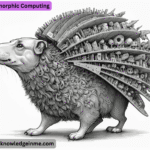Nuclear Power For AI Infrastructure The rapid growth of Artificial Intelligence (AI) demands immense computational power, leading to skyrocketing energy consumption. Data centers running AI models (like large language models, deep learning, and high-performance computing) require 24/7, reliable, and high-density power sources.
- Nuclear power—both traditional fission and emerging small modular reactors (SMRs)—could be a game-changer for AI infrastructure. Here’s why:
1. Why AI Needs Nuclear Power
Energy-Hungry AI Models:
- Training GPT-4 consumed ~50 GWh of electricity (equivalent to powering 40,000 homes for a year).
- Future AI models (e.g., GPT-5, multimodal AI) will demand 10-100x more power.
Data Center Power Density:
- AI workloads require 30-50 kW per rack (vs. 5-10 kW for traditional cloud computing).
24/7 Baseload Requirement:
- AI inference (real-time responses) needs always-on power—something intermittent renewables (solar/wind) struggle with.
2. How Nuclear Complements AI
- A. Traditional Nuclear Fission (Large Reactors)
High Capacity & Reliability:
- A single 1 GW reactor can power multiple data centers with zero carbon emissions.
- Example: Microsoft’s AI data centers partnered with Constellation Energy for nuclear-powered ops.
Long-Term Cost Stability:
- Unlike natural gas (price volatility), nuclear offers predictable energy costs over decades.
- B. Small Modular Reactors (SMRs) – The Future?
Scalability & Proximity to Data Centers:
- SMRs (e.g., Nu Scale, Ok lo) provide 50-300 MW, ideal for edge AI deployments.
- Could be built on-site (reducing transmission losses).
Safety & Faster Deployment:
- Modular designs reduce construction time (vs. 10+ years for traditional plants).
- C. Nuclear Fusion (Long-Term Hope)
Limitless Clean Energy?
- If commercialized (e.g., Helion, Commonwealth Fusion), fusion could provide near-infinite power for AI.
- Microsoft has a power purchase agreement with Helion for fusion energy by 2028.
3. Challenges & Considerations
Regulatory Hurdles:
- Nuclear licensing is slow (especially for SMRs).
Public Perception:
- “Nuclear” still faces stigma (despite being safer than fossil fuels).
Upfront Costs:
- High Cap Ex, but cheaper long-term than fossil fuels + carbon capture.
4. Who’s Betting on Nuclear for AI?
Company Initiative
Microsoft Partnered with Constellation Energy for nuclear-powered Azure cloud.
Amazon Exploring SMRs for AWS sustainability goals.
Google Researching geothermal + nuclear for AI ops.
Terra Power (Gates) Building Natrium reactors (advanced nuclear).
5. The Bottom Line
- SMRs could disrupt the market by enabling AI-powered microgrids.
- Fusion remains a wildcard—if cracked, it could make AI’s energy problem vanish.
Nuclear Power for AI Infrastructure: A Deep Dive
The explosive growth of AI—from large language models (LLMs) to real-time inference—is driving an unprecedented demand for energy. Data centers, which form the backbone of AI infrastructure, are now facing power scarcity, rising costs, and sustainability challenges.
- Nuclear power—both fission (traditional reactors & SMRs) and fusion—emerges as a compelling solution. Below, we explore:
- The Energy Crisis in AI
- Why Nuclear Fits Perfectly
- SMRs: The Game-Changer for AI Data Centers?
- Fusion: The Ultimate AI Power Source?
- Economic & Regulatory Realities
- Who’s Leading the Charge?
- Future Outlook & Challenges
1. The Energy Crisis in AI
AI’s Insatiable Power Demand
- Training GPT-4 consumed ~50 GWh (equivalent to the annual electricity use of 40,000 U.S. homes).
- GPT-5 and beyond could require 10-100x more energy.
- Nvidia’s AI chips (e.g., H100) consume 700+ watts each—a single AI server rack can hit 50-100 kW.
Data Centers Are Hitting Grid Limits
- Power density in AI data centers is 5-10x higher than traditional cloud computing.
- Ireland, Singapore, and Virginia are facing moratoriums on new data centers due to power shortages.
- Renewables alone can’t keep up—solar/wind are intermittent, and batteries are expensive at scale.
- AI needs a 24/7, high-density, clean power source. Nuclear fits.
2. Why Nuclear Fits Perfectly
- Traditional Nuclear Fission (Large Reactors)
- Massive Baseload Power – A single 1 GW reactor can power multiple hyperscale data centers.
- Zero Carbon Emissions – Unlike gas/coal, nuclear is clean and aligns with ESG goals.
- Stable Energy Prices – Less volatile than fossil fuels (critical for long-term AI ops).
Example:
- B. Small Modular Reactors (SMRs) – The AI Disruptor
- Can be built on-site – Reducing transmission losses and grid dependency.
- Faster to deploy (~3-5 years vs. 10+ for traditional plants).
Example:
- Open AI’s Sam Altman invested in Ok lo, an SMR startup aiming to power AI data centers.
- Amazon is exploring SMRs for AWS sustainability.
C. Nuclear Fusion – The Holy Grail?
- Theoretical “limitless” energy – No radioactive waste, no meltdown risk.
- Microsoft has a PPA with Helion (fusion startup) targeting commercial power by 2028.
- But Fusion is still years away from viability.
3. SMRs: The Best Near-Term Solution for AI
Why SMRs Make Sense for AI
Factor Traditional Nuclear SMRs
Power Output 1 GW+ 50-300 MW
Deployment Time 10+ years 3-5 years
Location Flexibility Needs large grid Can be on-site
Cost per MW High Cap Ex Lower (modular)
Top SMR Companies for AI
- Ok lo (Sam Altman-backed) – Aurora microreactor (15 MW).
- Nu Scale – First U.S.-approved SMR design (77 MW).
- Terra Power (Bill Gates) – Natrium reactor (345 MW, with molten salt storage).
- Expect AI giants to start buying SMRs by 2030.
4. Fusion: The Ultimate AI Power Source
- Helion Energy (backed by Open AI’s Altman & Peter Thiel) claims 50 MW fusion plant by 2028.
- Commonwealth Fusion (MIT spinout) aims for ARC reactor by early 2030s.
- TAE Technologies is working on hydrogen-boron fusion (cleaner than traditional deuterium-tritium).
- Problem: Fusion is still in the experimental phase. AI can’t wait.
5. Economic & Regulatory Realities
A. Costs
Energy Source Cost per MWh
Nuclear (existing) $30-$50
New Nuclear $60-$100+ (high Cap Ex)
SMRs (projected) $50-$80 (economies of scale needed)
Natural Gas $40-$80 (volatile prices)
Solar + Storage $60-$120 (intermittent)
Nuclear is competitive long-term, but needs policy support.
- B. Regulatory Hurdles
- NRC licensing is slow (SMRs are just getting approval).
- Public opposition (though AI companies may change perceptions).
6. Who’s Leading the Charge
Company Nuclear Initiative
Microsoft Nuclear PPA with Constellation Energy.
Open AI (Altman) Invested in Ok lo (SMRs).
Amazon Exploring SMRs for AWS.
Google Researching nuclear + geothermal.
Terra Power (Gates) Building Natrium reactor.
The Looming Energy Crisis in AI
- 1.1 The Staggering Power Demands of Modern AI
Training Costs:
- GPT-4: ~50 GWh (≈ $5M in electricity costs).
- GPT-5 (projected): 500 GWh–1 TWH (≈ $50M–$100M per training run).
- Multi-modal AI (video, 3D models) will be 10–100x more intensive.
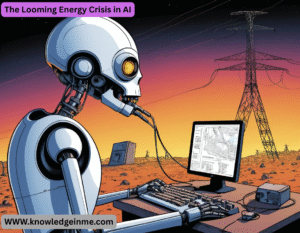
Inference Loads:
- Chat GPT serves 10+ million daily users, consuming 1 GWh/day (≈ 365 GWh/year).
- Real-time AI agents (e.g., Devin, Auto GPT) could multiply this demand.
1.2 Data Center Power Density Explosion
Era Power per Rack Total Facility Load
Traditional Cloud (2010s) 5–10 kW 10–30 MW
AI Training (2024) 30–50 kW 50–100 MW
Next-Gen AI (2030) 100+ kW 200–500 MW
- Problem: Many grids (e.g., Ireland, Singapore, Northern Virginia) are rejecting new data centers due to power shortages.
1.3 Why Renewables Alone Can’t Solve This
- Solar/Wind: Intermittent (30–50% capacity factor).
- Batteries: Too expensive for multi-day storage (AI needs 24/7 power).
- Hydrogen: Still 5–10 years away from scalability.
- AI needs a zero-carbon, always-on, high-density power source. Nuclear is the only viable option.
2. Nuclear Technologies for AI: A Breakdown
- 2.1 Traditional Nuclear Fission (GW-scale Reactors)
Pros:
- 1 GW = Power for 5–10 hyperscale AI data centers.
- 80–90% capacity factor (vs. 30% for solar, 50% for wind).
- Zero CO₂ emissions (AI companies face ESG pressure).
Cons:
- 10+ year construction timelines.
- $10B+ capital costs (only viable for mega-campuses like Microsoft/Google).
Case Study:
- Microsoft’s Virginia data centers now buying nuclear power from Constellation Energy.
- 2.2 Small Modular Reactors (SMRs) – The AI Game-Changer
Why SMRs Fit AI Perfectly
- On-site deployment: Eliminates grid bottlenecks.
- Faster build time: 3–5 years vs. 10+ for traditional plants.
2.3 Microreactors (1–10 MW) – For Edge AI
- Example: Westinghouse’s e Vinci (5 MW).
- Use case: On-site power for AI inference clusters.
- 2.4 Nuclear Fusion – The Wildcard
Potential:
- Helion Energy (Altman-backed) claims 50 MW fusion plant by 2028.
- Commonwealth Fusion (MIT) targeting ARC reactor by 2030s.

